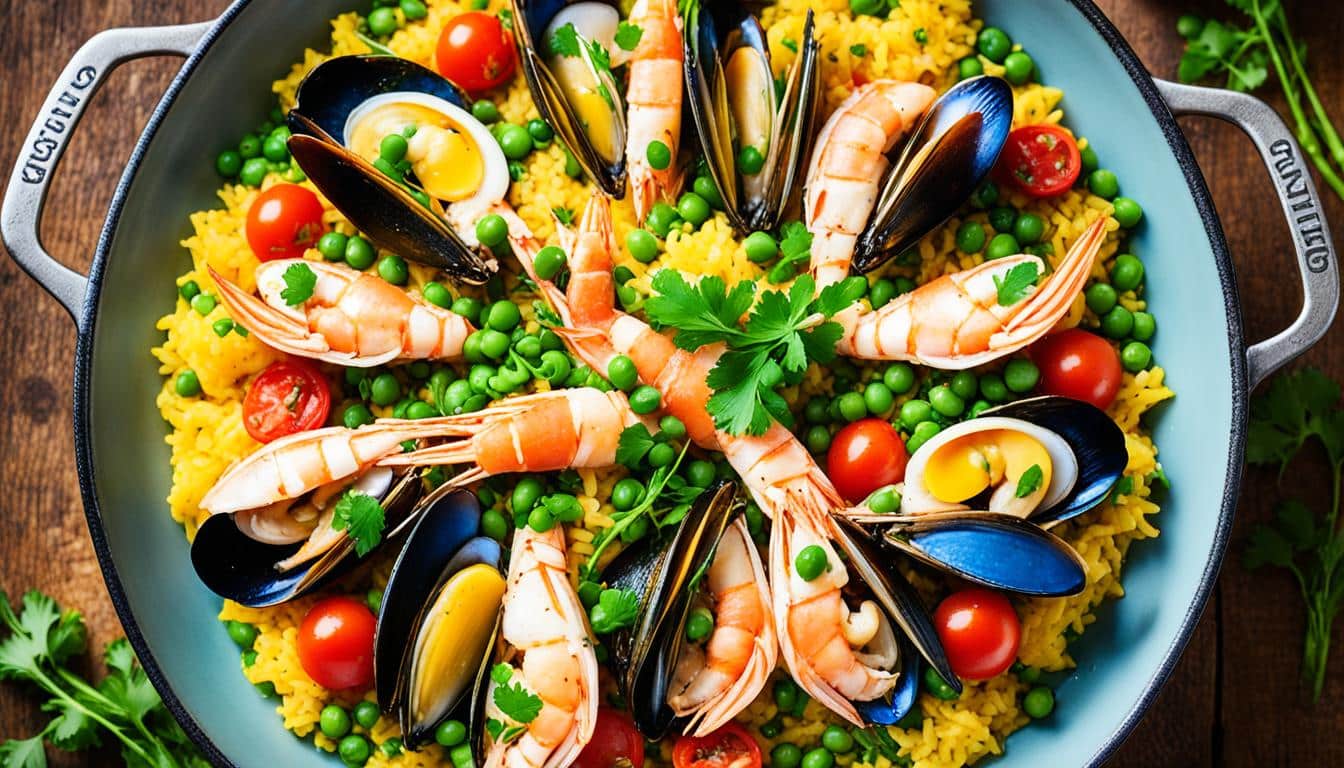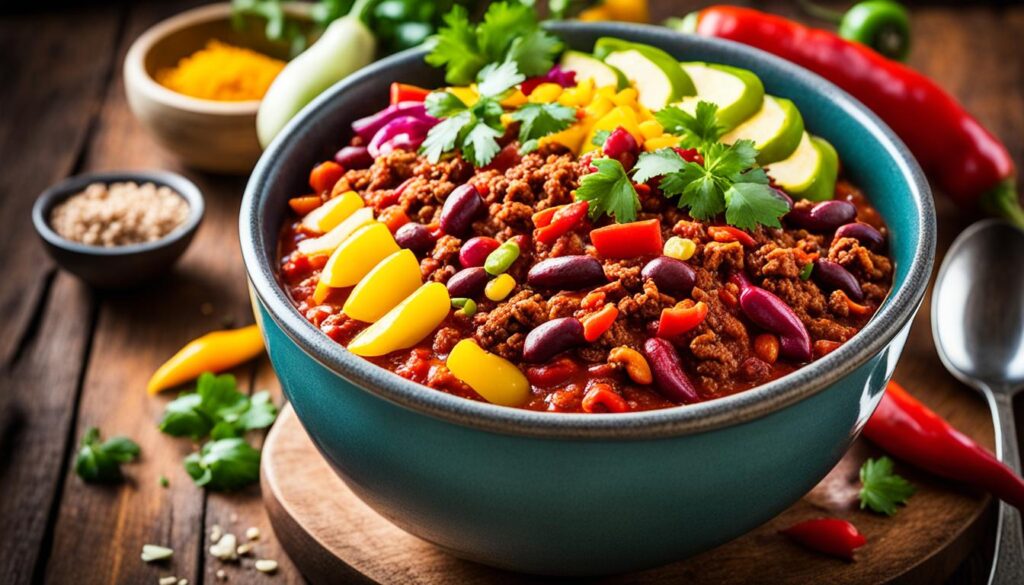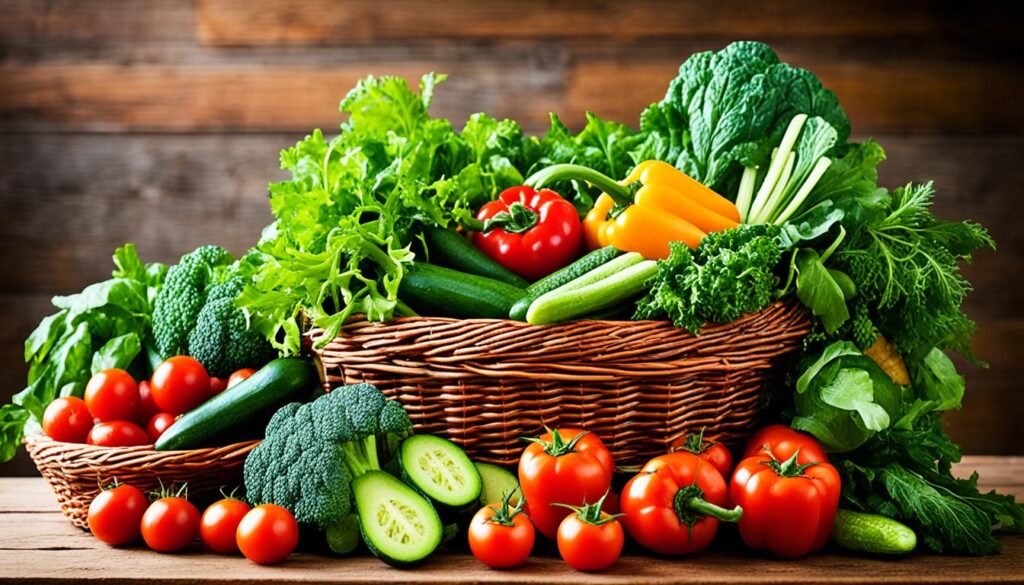Simple Seafood Paella Are you ready to embark on a culinary adventure with a dish that will impress everyone at the dinner table? Look no further than our simple seafood paella recipe, perfect for beginners. This saffron-infused delight combines the flavors of rice, fresh seafood, and aromatic vegetables to create a mouthwatering experience that will transport you straight to Spain.
Key Takeaways:
- Seafood paella is a flavorful Spanish rice dish that can be easily made at home.
- It requires simple ingredients that are readily accessible, making it ideal for beginners.
- Choosing the right type of rice, such as medium-grain rice, is crucial for achieving the perfect texture.
- While a traditional paella pan is recommended, a large skillet can work just as well.
- Follow these step-by-step instructions and helpful tips to create a memorable seafood paella that will wow your friends and family.
What is Paella?
Paella, a beloved Spanish dish, is a traditional rice dish that originated in Valencia. It has become an iconic representation of Spanish cuisine around the world. This flavorful dish combines saffron-infused rice with a delightful variety of ingredients, including seafood, meat, and vegetables.
The word “paella” is believed to have its roots in the Arabic word “baquia,” meaning “leftovers.” It was originally created as a practical way to use up various leftover ingredients. Over time, paella has evolved into a culinary masterpiece, with different regions and chefs adding their own twists.
Paella is known for its vibrant yellow color and distinct taste. The saffron threads used to infuse the rice give it a floral and slightly earthy flavor. The seafood, such as shrimp, lobster, and mussels, adds a rich and savory element, while the vegetables bring freshness and texture to the dish.
“Paella is a celebration of flavors, a harmonious blend of ingredients that come together to create a truly unforgettable culinary experience.”
Here is an image that captures the essence of paella:
What is in Paella?
The ingredients in paella can vary depending on the region and the chef’s preferences. However, there are a few key ingredients that are typically found in most paella recipes. These ingredients come together to create a flavorful and aromatic dish that exemplifies the essence of Spanish cuisine.
Saffron
One of the essential ingredients in paella is saffron. This precious spice adds a distinctive flavor and a vibrant yellow color to the dish. Saffron threads are often mixed with warm water or broth to release their aroma and infuse the rice with their unique taste.
Rice
Rice is a crucial component of paella, providing the base for the dish. The type of rice used in paella is typically medium-grain rice, which has the perfect texture and ability to absorb the flavorful broth. Round Spanish rice, such as “bomba” rice, is ideal, but medium-grain rice like Goya medium-grain rice also works well.
Seafood
Seafood is a popular choice in seafood paella and adds a delicious element to the dish. Shrimp, lobster, mussels, and clams are commonly used to create a delightful medley of flavors. The seafood is cooked with the rice and absorbs the saffron-infused broth, resulting in a rich and satisfying dish.
Chicken and Vegetables
In addition to seafood, paella often includes chicken and an array of vegetables. Chicken adds a savory element to the dish, while vegetables like onions, bell peppers, and tomatoes provide texture, color, and depth of flavor. Various spices and herbs, such as paprika, garlic, and parsley, are also commonly used to enhance the taste of the dish.
By using these key ingredients, paella achieves its signature taste and becomes a beloved dish all around the world. The combination of saffron-infused rice, flavorful seafood, tender chicken, and vibrant vegetables creates a harmony of flavors that is sure to delight your taste buds. Whether you’re a seafood lover or prefer a mix of meats and vegetables, paella offers endless possibilities for customization and enjoyment.
What Kind of Rice to Use in Paella?
The type of rice used in paella is crucial to achieving the right texture and flavor. It is recommended to use medium-grain rice that can absorb the flavors of the broth while maintaining some bite and firmness. Round Spanish rice, like the one called “bomba” rice, is ideal but may not be readily available. A good substitute is medium-grain rice like Goya medium-grain rice. Long-grain rice or arborio rice, which is typically used in risotto, are not suitable for paella as they tend to become mushy. The rice is often infused with the flavors of saffron threads, giving it a delicate and aromatic taste.
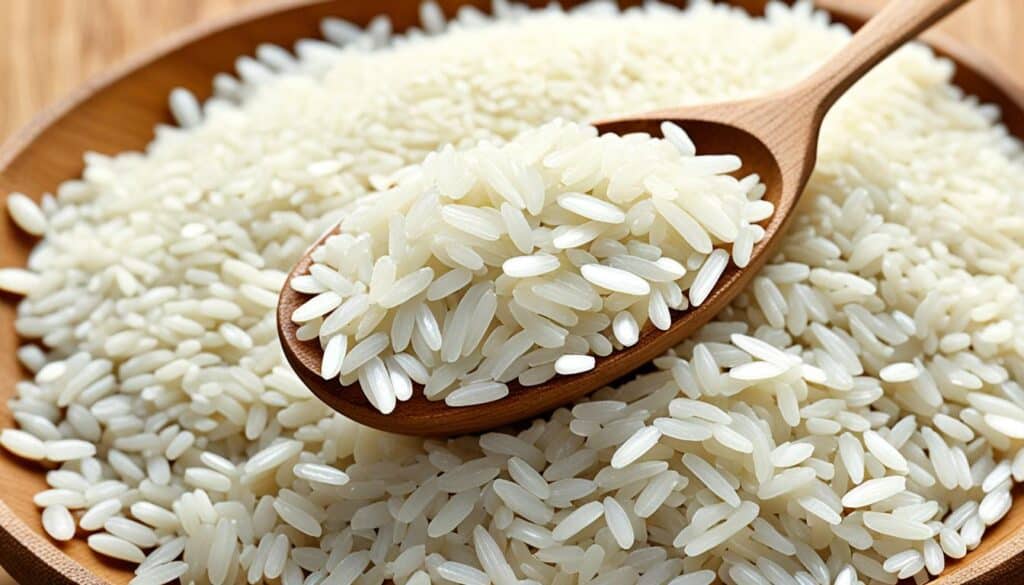
| Type of Rice | Texture | Suitable for Paella? |
|---|---|---|
| Medium-Grain Rice | Firm with some bite | Yes |
| Bomba Rice | Round and plump | Ideal |
| Goya Medium-Grain Rice | Firm with some bite | Good substitute |
| Long-Grain Rice | Soft and separate | No |
| Arborio Rice | Sticky and creamy | No |
How to Make Seafood Paella Step-by-Step
Making seafood paella may seem daunting to beginners, but it can be broken down into simple steps. Here is a step-by-step guide to making delicious seafood paella:
- Prepare your ingredients:
- 1 cup of medium-grain rice
- 2 cups of chicken or vegetable broth
- 1 pound of mixed seafood (shrimp, mussels, clams)
- 1 onion, chopped
- 1 red bell pepper, sliced
- 2 cloves of garlic, minced
- 1 teaspoon of smoked paprika
- A pinch of saffron threads
- Salt and pepper to taste
- Chopped parsley for garnish
- Heat a large skillet or paella pan over medium heat and add olive oil.<blockquote>Tip: A traditional paella pan is ideal for making seafood paella, but a large skillet will work just as well. </blockquote>
- Add the chopped onion, sliced bell pepper, and minced garlic to the pan. Cook until the vegetables are softened.
- Add the smoked paprika and saffron threads to the pan. Stir well to coat the vegetables.
- Add the rice to the pan and stir to coat the rice with the olive oil and spices.
- Pour in the chicken or vegetable broth and bring to a simmer. Cover the pan and cook for about 15 minutes, or until the rice is almost tender.
- Add the mixed seafood to the pan, nestling it into the rice. Cover again and cook for an additional 5 minutes, or until the seafood is cooked through and the rice is tender.
- Remove the pan from heat and let it rest for 5 minutes.
- Garnish with chopped parsley and serve hot.
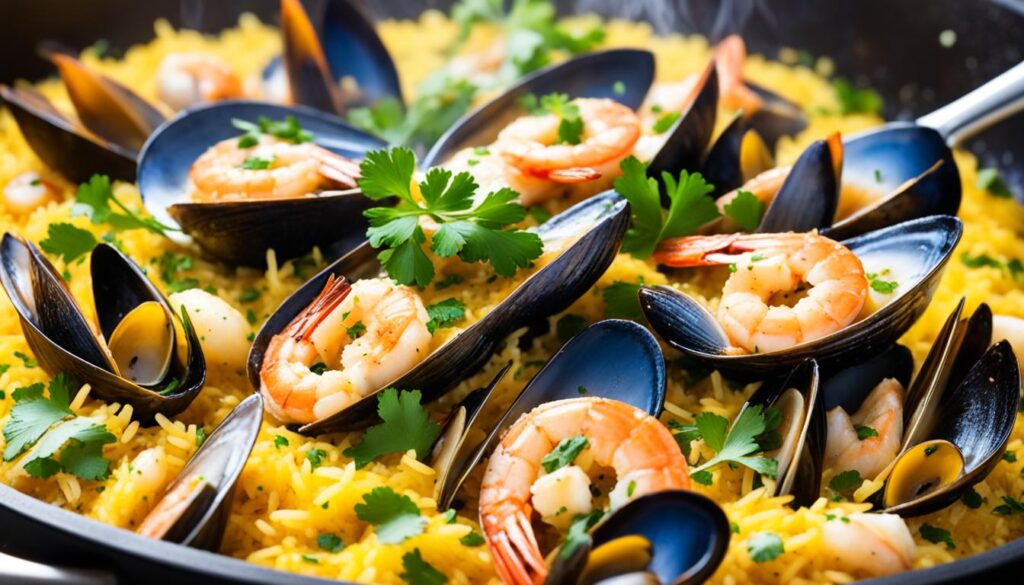
Choosing the Right Pan for Seafood Paella
When it comes to making seafood paella, having the right pan is important for achieving the perfect results. While a traditional paella pan is ideal, it is not necessary to invest in one if you don’t have it. A large and sturdy skillet, such as a cast iron skillet, can work just as well for cooking this delicious dish.
When choosing a pan for seafood paella, the key is to select one with a large and even surface. This will ensure that the rice cooks properly and quickly, allowing the flavors to meld together harmoniously. A wide pan also provides enough space for the seafood, vegetables, and rice to cook evenly without overcrowding.
Avoid using a round-bottomed wok for making paella, as it can create uneven heat distribution and may not have enough surface area for the rice to cook properly. The goal is to have the rice cook evenly and develop the delicious crust at the bottom, known as socarrat.

If you prefer to use a paella pan, there are different options available, including carbon steel, stainless steel, and enamel-coated pans. Carbon steel pans are the most traditional choice, offering excellent heat distribution, while stainless steel pans are durable and resistant to corrosion. Enamel-coated pans provide a non-stick surface, making them easy to clean.
Ultimately, the choice of pan depends on your personal preference and the tools available in your kitchen. The most important factor is to ensure that the pan is large, sturdy, and provides even heat distribution for the best results.
Tips for Making the Perfect Seafood Paella
If you want to impress your guests with a delicious seafood paella, follow these tips to ensure a perfect result:
- Use high-quality ingredients: Fresh seafood and high-quality rice are key to a flavorful paella. Opt for fresh shrimp, lobster, or mussels. And choose a medium-grain rice that can absorb the flavors well.
- Prep your ingredients: Before you start cooking, make sure all your ingredients are clean and prepped. Peel and devein the shrimp, clean the mussels, and chop the vegetables. This will save you time during the cooking process.
- Toast the rice: Toasting the rice before adding the liquid enhances its flavor and ensures a nice texture. Spread the rice evenly in the pan and let it toast slightly before adding the broth.
- Infuse the broth: To infuse the broth with flavors, add saffron threads and any other spices or herbs you like. Let the broth simmer for a few minutes to allow the flavors to meld together.
- Layer the ingredients: When adding the ingredients to the pan, start with the proteins like shrimp and lobster, followed by the vegetables and rice. This allows the proteins to cook evenly and infuse the flavors into the rice.
- Don’t stir too much: Although it can be tempting to stir the paella constantly, it’s important to resist the urge. Stirring too much can release too much starch from the rice and lead to a mushy texture. Instead, let the paella cook undisturbed to develop a crispy crust at the bottom, called socarrat.
- Allow it to rest: After the paella is cooked, remove it from the heat and let it rest for a few minutes. This allows the flavors to settle and the rice to absorb any remaining liquid.

With these tips in mind, you’ll be able to create a perfectly cooked and flavorful seafood paella. Your guests will be impressed by your culinary skills!
Variations of Seafood Paella
Seafood paella is a versatile dish that can be customized to suit personal preferences. Here are some popular variations:
1. Chorizo and Seafood Paella
This variation adds a smoky and spicy kick to the traditional seafood paella by incorporating chorizo, a flavorful Spanish sausage. The addition of chorizo gives the dish a rich and robust flavor that pairs perfectly with the seafood. The combination of the tender shellfish, fish, and chorizo creates a tantalizing medley of flavors.
2. Shellfish-Only Paella
If you’re a fan of shellfish, this variation is for you. Instead of using a variety of seafood, this paella focuses solely on shellfish like mussels, clams, and shrimp. The briny flavors of the shellfish shine through in this version, while still maintaining the signature saffron-infused rice that makes paella so unique.
3. Fish and Vegetable Paella
For those who prefer a lighter and vegetarian-friendly option, fish and vegetable paella is an excellent choice. This variation replaces the traditional seafood with a selection of tender fish fillets and an assortment of colorful vegetables such as bell peppers, peas, and artichokes. The result is a vibrant and nutritious paella that is both satisfying and flavorful.
| Variation | Ingredients |
|---|---|
| Chorizo and Seafood Paella | Chorizo, shrimp, fish, mussels, clams, saffron rice, bell peppers, onions, garlic, tomatoes, chicken broth, olive oil |
| Shellfish-Only Paella | Mussels, clams, shrimp, saffron rice, onions, garlic, tomatoes, chicken broth, olive oil |
| Fish and Vegetable Paella | Fish fillets (such as cod or halibut), bell peppers, onions, garlic, tomatoes, peas, artichokes, saffron rice, vegetable broth, olive oil |
These variations allow you to experiment with different flavors and ingredients while still capturing the essence of a traditional seafood paella. Whether you prefer the smoky heat of chorizo, the delicate sweetness of shellfish, or the freshness of fish and vegetables, there’s a variation of seafood paella to suit every palate.
Serving Seafood Paella
Seafood paella is best served fresh and hot, straight from the pan. Its vibrant colors and enticing aroma make it an inviting dish. The communal aspect of serving paella adds to the dining experience, as everyone gathers around the pan to enjoy the flavorful medley of seafood and rice together.
To complement the rich flavors of the paella, consider pairing it with a crisp white wine or a refreshing glass of sangria. The light and bright notes of the wine or sangria help balance the rich and savory elements of the dish, elevating the dining experience.
If you’re looking to create a complete Spanish dining experience, consider starting the meal with a chilled tomato Gazpacho. This traditional Spanish soup, made with ripe tomatoes, cucumbers, bell peppers, and other refreshing ingredients, is the perfect appetizer to awaken the palate and prepare it for the main course.
Also Read:- 10 Immune-Boosting Foods To Add To Your Diet
For a delightful ending to your seafood paella feast, indulge in Crema Catalana, Spain’s version of crème brûlée. This creamy custard dessert, infused with hints of citrus and vanilla, is topped with a caramelized sugar crust, adding a satisfying crunch and a touch of sweetness.
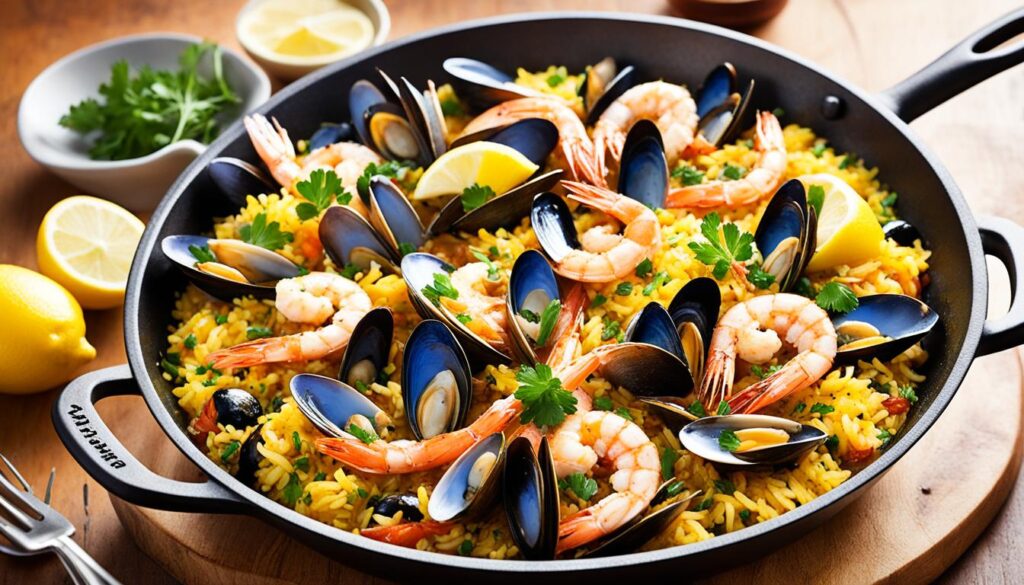
| Accompaniments | Description |
|---|---|
| White Wine | A crisp and light white wine, such as Albariño or Verdejo, complements the seafood flavors of the paella. |
| Sangria | A refreshing blend of red wine, fruits, and spices, sangria adds a festive touch to the meal. |
| Chilled Tomato Gazpacho | Start the meal with a refreshing bowl of chilled tomato Gazpacho to awaken the taste buds. |
| Crema Catalana | Finish the meal with a creamy and caramelized Crema Catalana for a satisfying dessert. |
Conclusion
Seafood paella is a delicious and satisfying dish that captures the flavors of Spain. With the right ingredients and techniques, it is easy enough for beginners to make at home. Whether you choose to stick to the traditional recipe or add your own twist with different ingredients, seafood paella is sure to impress your family and friends. So why wait for a special occasion? Grab your skillet, gather your ingredients, and start cooking this simple seafood paella recipe today!
FAQs
Q: What is a paella pan?
A: A paella pan is a wide, shallow pan traditionally used to cook paella, a Spanish rice dish.
Q: How do I make paella?
A: To make paella, you start by sautéing onions and garlic, then adding rice, broth, and your choice of proteins like chicken, seafood, or chorizo add the onion.
Q: What are the key ingredients in a seafood paella recipe?
A: The key ingredients in a seafood paella recipe typically include rice, seafood such as shrimp and mussels, broth, onions, garlic, and saffron ,paella rice.
Q: Can you recommend an easy seafood paella recipe for beginners?
A: Yes, an easy seafood paella recipe for beginners usually involves using simple ingredients, such as shrimp, fish, and rice, and following basic cooking steps.
Q: What type of rice is best for paella?
A: The best rice for paella is typically medium-grain rice, such as Bomba or Calasparra rice, which absorbs flavors well and retains a firm texture when cooked.
Q: Is there a traditional way to cook paella?
A: Yes, the traditional way to cook paella involves using a paella pan over an open flame or grill, layering ingredients, and allowing the rice to develop a crust at the bottom.
Q: How can I make an easy paella recipe if I don’t like seafood?
A: If you don’t like seafood, you can make an easy paella recipe using chicken thighs, chorizo, or other meats as the main protein instead.
Q: Can I make a one-pot version of paella?
A: Yes, you can make a one-pot version of paella by combining all the ingredients in a large pot or skillet and cooking them together until the rice is cooked and the flavors have melded.
Conclusion
Seafood paella is a delicious and satisfying dish that captures the flavors of Spain. With the right ingredients and techniques, it is easy enough for beginners to make at home. Whether you choose to stick to the traditional recipe or add your own twist, seafood paella is sure to impress your family and friends.
